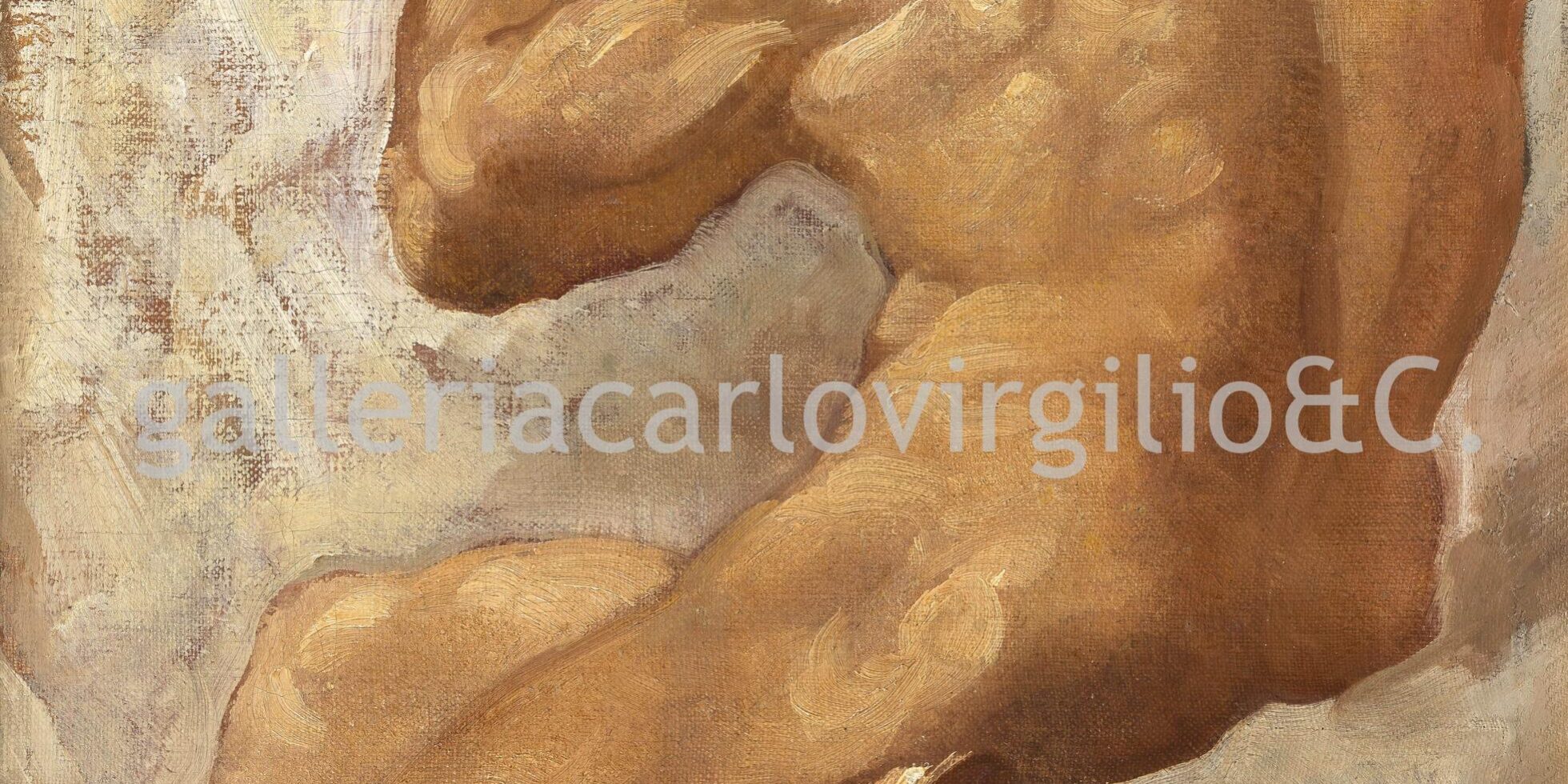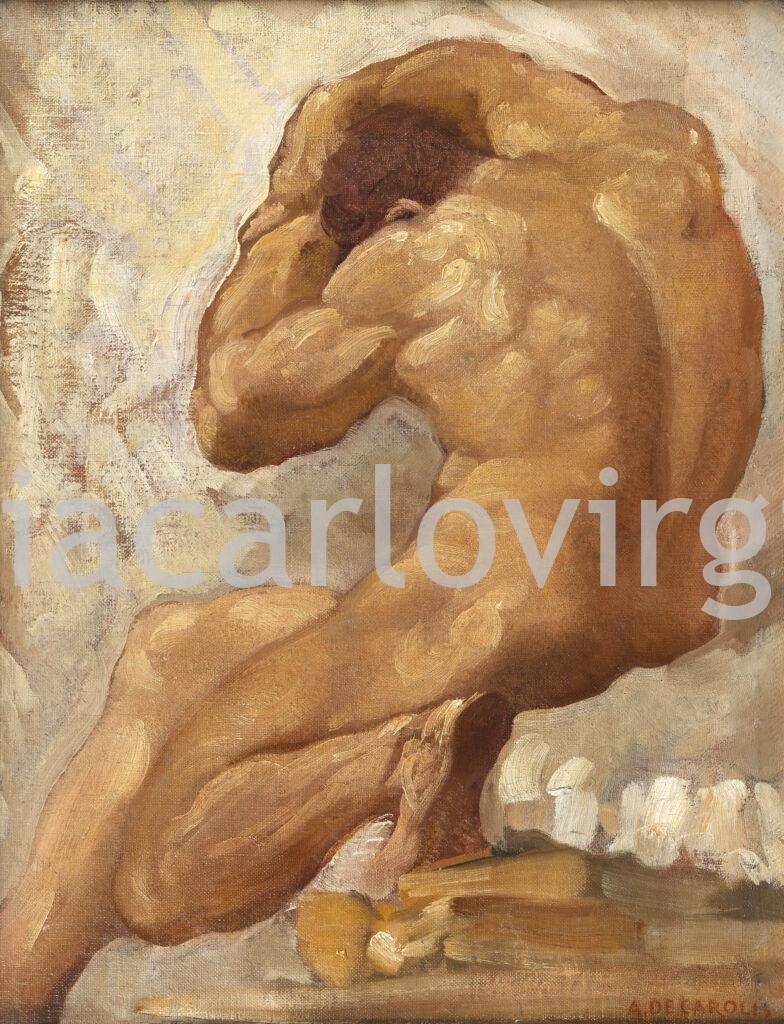| AVAILABLE

Adolfo De Carolis
Montefiore dell’Aso 1874 – Rome 1928
Study for male nude on the left tympanum of Aemilius for Palazzo del Podestà in Bologna • 1911-12
Oil on canvas , 60,5 x 77 cm
Selected bibliography for Palazzo del Podestà: Pel salone del Podestà, Lettera al direttore, in “Il resto del Carlino”, 15 novembre 1908; Giorgio Gavasci, La decorazione del Palazzo del Podestà, in “Picenum”, 1911, p. 151-152; Ascanio Forti, Tra i miti e i simboli del Salone del Podestà, 29 novembre 1913; Decio Buffoni, Gli affreschi di Adolfo De Carolis nel Salone del Podestà di Bologna, in “Il progresso”, 15 gennaio 1921; Renato Barilli, Bistolfi e De Carolis a Bologna, in Aa. Vv., Il Liberty a Bologna e nell’Emilia Romagna: architettura, arti applicate e grafica, pittura e scultura, exh. cat. Bologna 1977, Grafis, Bologna 1977; Franco Solmi, Adolfo De Carolis: la sintesi immaginaria. Gli affreschi del Salone del Podestà di Bologna, Grafis, Bologna 1979; Simonetta Di Pino Giambi, Adolfo De Carolis. Il piacere dell’arte, Pitti Arte e Libri, Florence 1992.
By winning the 1907 competition launched by Società Francesco Francia for the monumental and ambitious project to decorate the Palazzo del Podestà in Bologna, Adolfo De Carolis could turn to account the much-cherished dream of a grand design bringing together the values of painting and sculpture, with an insistent nod to Michelangelo Buonarroti.
The contract allowed De Carolis to make use of assistants, but only for secondary aspects, there being an explicit stipulation that the Maestro carry out all principle elements himself.
Bologna was the perfect place for this type of neo-sixteenth-century experiment, given the importance of Bolognese aestheticism, not least due to Alfonso Rubbiani and his guild, Aemilia Ars, and De Carolis with his pre-Raphaelite tendencies – he habitually dressed in tunics and sixteenth-century headwear – was the ideal artist for a revivalist undertaking.
The fresco cycle at Palazzo del Podestà took Adolfo De Carolis almost twenty years to complete, as at the same time he was involved in the decoration of Palazzo della Sapienza in Pisa, where he was committed to working, including stops and starts, from 1915 to 1920.
The artist moved to Bologna in the spring of 1910 to prepare the first cartoons, although work on the scaffolding only really began in June 1911. Solmi, who wrote an exhaustive account of the cycle (cfr. Franco Solmi, Adolfo De Carolis: la sintesi immaginaria, Grafis, Bologna 1979) deduced from coeval photographs that by November 1912 De Carolis had already finished the decoration of the whole part looking out towards Piazza del Nettuno: the Ancient World, Eridanus with two decorative figures, the spandrels Aurora and Night, the corbels Etruscus, Italicus and Aemilius and the spandrels of Earth, Air, Water, The Natural World and The Human World. In the interview he gave in November 1913 published in “Il Resto del Carlino,” De Carolis does indeed state: “400 of the 1,000 square metres entrusted to me are finished. Soon I hope to complete the ceiling, the mystical and celestial part of my work. The portrayal of the ancient world, its images, fantasies and heroes is complete” (Ascanio Forti, Tra i miti e i simboli del Salone del Podestà, in “Il Resto del Carlino”, 29 November 1913).
In the photographs accompanying the article, parts of the fresco are visible showing the vault with Rhenus, the corbels Gallus, Irnerius and Petronius, and the completed spandrels Water and Fire (cfr. Solmi 1979, pp. 40-41).
However, soon afterwards the undertaking encountered technical problems due to the poor quality of the plaster on the walls and ceiling, as well as economic problems from a lack of finance caused by Italy entering the war. As a result the project dragged on right up to the painter’s death, although the numerous drawings and sketches he left meant work could begin again in 1929, taken up by the pupils who had assisted him before. From a photograph taken during work on the Bolognese cycle we can identify the assistants: Ferruccio Pasqui, Gino Barbieri (who died in the war), Diego Pettinelli and Armando Spadini.
Our study is of the left hand figure leaning on the arched broken pediment with scrolls, Michelangelesque in type, framing the figure of Aemilius; in the narrative intentions of the artist, the chosen character marking the passage of the Etruscan forefathers to Roman Bononia (Latin for Bologna).
There are some drawings in red chalk of this area of the whole composition (Collezione Cassa di Risparmio di Fermo, Fermo), but none specifically of the figure in our study. In fact the artist often used to draw directly on the canvas, as can be seen through infrared reflectography, carried out on some oil sketches for conservation purposes, which shows the summary sketched lines of the nudes.
The chromatic layer, based exclusively on burnt sienna, zinc white, vermilion and chrome-based pigments, is typical of works relating to Bologna and the ductus, in particular that of the left foot, reveals the typical hand of the artist from the Marche and not that of one of this pupils, despite them working on many of these sketches. The approximate methods of this painting can be seen alongside the artist’s sketches conserved in the Sala Adolfo De Carolis of the Polo Museale at San Francesco di Montefiore dell’Aso, certainly autographed.
As concerns the signature “A. De Carolis”, which the painter placed in the bottom right hand corner, it should be mentioned that he did not generally sign sketches, but in the light of a sale, made in the years when the artist was still living, some of these works went from being elements of a series to paintings in their own right, so it was appropriate that they were signed.
Francesco Parisi
For further information, to buy or sell works by De Carolis Adolfo (1874-1928) or to request free estimates and evaluations
mail info@carlovirgilio.co.uk
whatsapp +39 3382427650
